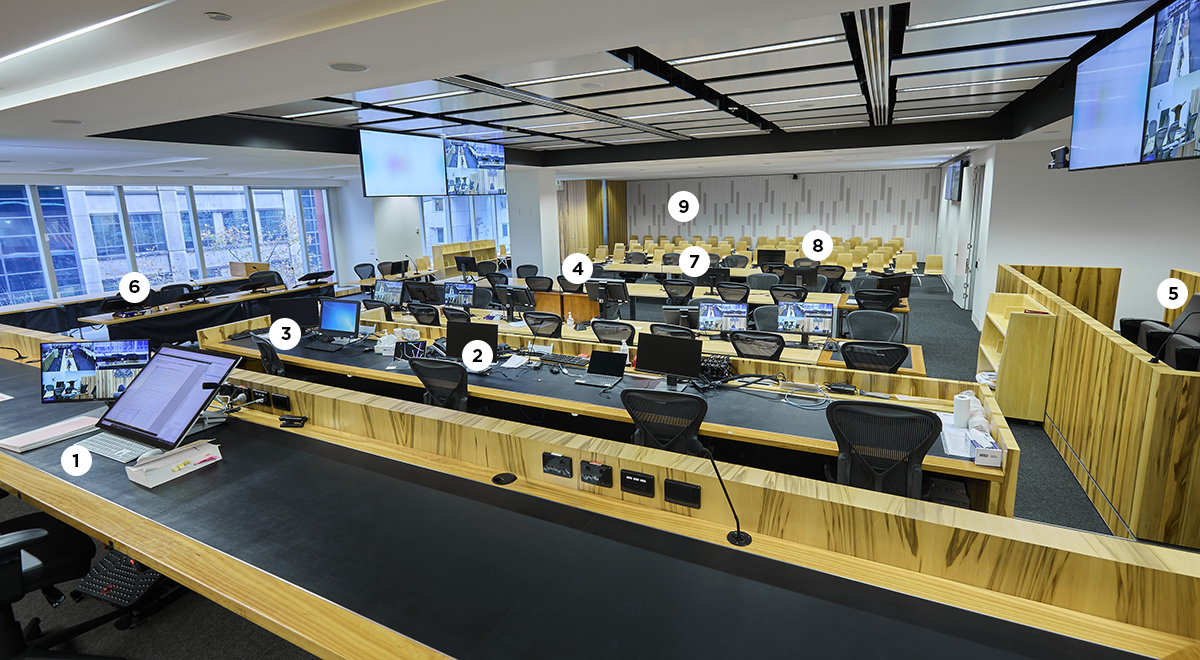Do you know who’s who in a civil courtroom?
In a civil courtroom in the Supreme Court, you will see a judge, a judge's associate, and lawyers, each playing a vital role in Court proceedings.
In some matters, there may be a second associate or tipstaff, and a jury. Keep reading to learn about the role each person plays in a civil courtroom.
In this photo of a civil courtroom, you can see the view from the judge's Bench. Learn more about who's who in a civil courtroom by matching the numbers in the photo to the descriptions below.

1 – Judge
In the Supreme Court, judges, associate judges, and judicial registrars sit on the Bench to hear matters. Judges wear black robes in court when hearing some matters; for some hearings they wear business attire. The judge is an impartial referee who ensures the law and correct procedures are followed in civil cases. A civil trial can be held by judge alone, or by judge and jury. The judge will make rulings on legal issues which arise during civil proceedings. If a trial is heard by a judge alone, the judge will also make findings of fact based on the evidence.
2 – Judge’s associate
The judge’s associate sits directly in front of the judge in the courtroom. They perform a range of administrative and courtroom duties to support a judge including empanelling a jury, managing the people in Court, and taking notes.
3 – Tipstaff/second associate
A tipstaff or second associate sits next to the judge’s associate. They are responsible for opening and closing courtroom proceedings, swearing in witnesses, and looking after the jury during a trial.
4 – Lawyers
Lawyers (barristers and solicitors) sit at the Bar table. Barristers, who may be dressed in gowns, face the judge, while solicitors are usually seated directly opposite and face the body of the courtroom. The plaintiff’s lawyers sit closest to the jury, and the lawyers or the defendant sit next to the witness box.
5 – Jury
In the Supreme Court, many civil matters are heard by judge alone, where they will rule if the defendant is at fault and award damages or some other remedy.
Some civil trials are heard by a judge and jury if either party makes this request. A jury in a civil trial is made up of six or more people selected randomly from the electoral roll. A judge will direct the jury on legal matters and the jury will decide the facts and apply the law to those facts. The jury will decide whether the plaintiff has established the claim being made and in most cases the damages (or money) to be awarded. There are usually no juries in commercial trials.
6 – Witnesses
Witnesses give evidence about what they have heard, seen or otherwise perceived relevant to the case they are involved in. A witness will usually stand in the witness box to give their evidence once they have made an oath or affirmation (i.e. a statement) to be truthful. Some witnesses will give their evidence remotely via an audio-visual link. Witnesses are asked questions by the lawyers representing the parties – this is called being examined, cross-examined and re-examined.
7 – Plaintiff/Defendant
In civil trials, the plaintiff and defendant sit behind the lawyers facing the judge. The plaintiff is the person who brings the case to the Court. The defendant is the person who disputes the claims made by the plaintiff.
8 – Media
Members of the media have a section of the courtroom to sit in to take notes when reporting on a case. In civil courtrooms, members of the media usually sit in the public gallery.
9 – The Public
Members of the public sit at the rear of the courtroom in the public gallery. There’s also an option to watch some hearings and judgments online as some proceedings are available for public viewing via live stream.
Transcripts & Court Reporters
All civil hearings in the Court are recorded and some, especially trials, are transcribed. Transcripts are used by the judge, jury and lawyers involved in a case. Transcription is usually done remotely but on rare occasions, a court reporter may sit beside the judge on the Bench and transcribe everything that is said during a trial.
Defamation. Often salacious or scandalous, especially when it involves Hollywood Stars or high-profile federal politicians. It’s about defending one’s honour - and earning capacity. It’s an area of law where a person’s right to protect their reputation rubs up against someone else’s freedom of expression.
